I once wrote a story of my visit to El Nido on March 2021 and my encounter with the lovable Rockskipper and its neighbor, the Lined Shore Crab. Having enjoyed our time there, we planned an encore El Nido trip a month later.
We dragged along my parents, together with my brothers and their families. Knowing the bustling wildlife nightlife on the beach after sundown, we visited two beach locations on separate nights for the three days that we stayed there – first, at Buko Beach Resort of Sitio Lugadia, Barangay Corong-corong, El Nido, then at Maremegmeg Beach Club in the same barangay.
We had no specific criteria for choosing these locations. It just so happened that only those two resorts could accommodate our big group at that time, considering the social distancing and crowd reduction requirements.
Each resort hosted about half of our group. This turned out to be a good thing, because both resorts provided worthy accommodations and their beach proved to be rich in wildlife. We spent our first night in Buko Beach Resort, and the next at Maremegmeg Beach Club.
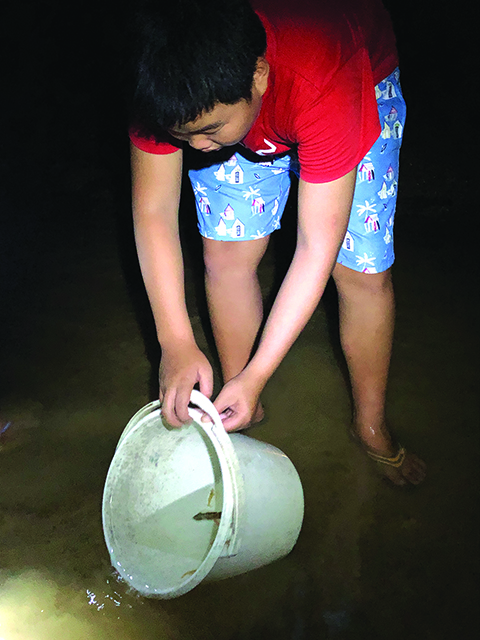
NIGHT TRIPS
I planned ahead for the night trip, bringing with me two generic waterproof flashlights and extra batteries, just in case. Naturally, the trusty cellphone was a must. It enabled me to call for backup, it had its own camera, and the built-in flashlight had been useful in many occasions.
My fine net with handle was ideal for those scenarios. They are similar to the ones you would usually use for your aquariums, except that I tripled the depth of my net. so that the captured animal won’t jump out, although many of my quarry are still able to do so and escape. The deep net also provides more cushion for the animal, thus reducing chances of injury.
As I readied our tools, my lovely wife readied our travel permits and QR code. You would think that we were going abroad with all the document preparations, but we were actually just going to have a four-hour road trip to El Nido 270 kilometers from our house.
I would like to assure our readers that all of the specimens caught during this trip, and even those from the March 2021 trip, were released back into the water after the picture taking. I also tried to educate my army of pamangkins concerning these creatures before releasing them back into the water
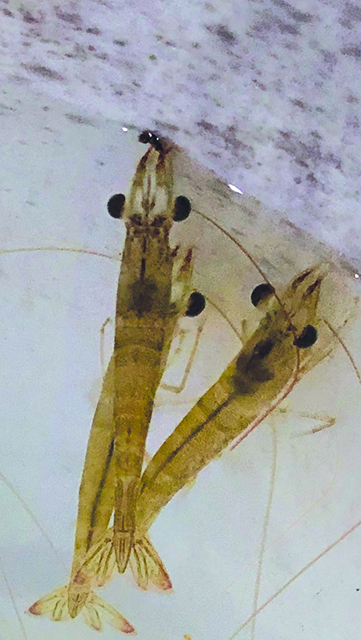
CURIOUS CREATURE
Our night trip would usually last two to three hours at a time. Once we started to see interesting animals sleeping or swimming about, it was hard to resist the urge to keep looking for more. We were very fortunate that it was low tide on this particular night in Buko Beach Resort. We always saw more sea creatures during low tide because, instead of waiting for them to approach shore (many creatures were attracted to the light), we could go far wading in the water without having to swim.
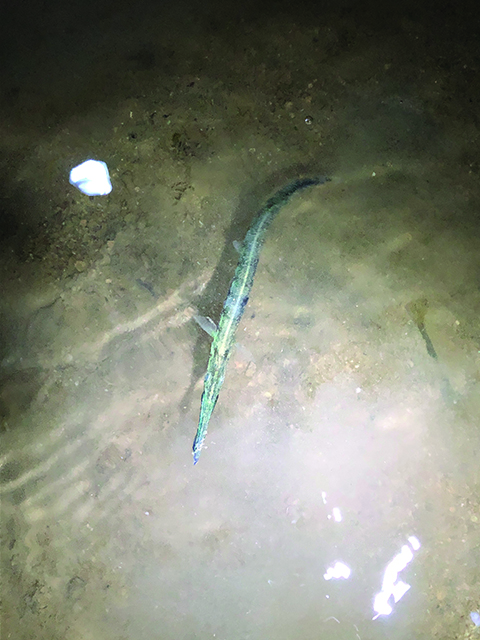
I was with my kids and pamangkins, so getting our clothes wet was not an option. Otherwise, I would be grounded by their mommies. So, we had to keep it basic: maximum depth at knee-deep water and wrap up by 10 PM.
We were not seeing anything interesting at first. It was not that we were not enjoying ourselves. There were a lot of small, inch-long fishes that were either sleeping or blinded by the light, so you could actually snatch them out of the water by hand like a Kung Fu master. A good number of Suahe could also be scooped up with a net.The bigger creatures (three inches and bigger) were more skittish and harder to catch. Although they were partially blinded by the light, they kept on moving and would Appealdash away when they detected movement. We were able to catch two different species of needlefish, with the biggest measuring to 7inches long.
I was about to call it a night when I noticed a strange shadow floating nearby. I was intrigued that this object seemed to be floating in a pattern rather than just floating with the current. It approached me as I walked farther away, but it kept a certain distance when I tried to approach it.
As I focused the beam of my flashlight on it, I finally figured out that this object was actually a juvenile squid about 5 inches long. Just like many other creatures, it was drawn towards our light, but it was very cautious. It approached us very gradually to observe what was happening. I focused my beam into its eyes, hoping that it would not notice my advance. To no surprise, it was smart and apprehensive. Its jet-like propulsion allowed it to dash off every time I made sudden movements. As I got closer, it could sense my presence and it made a threatening stance by shaping its tentacles to look like a two-pronged pitchfork. The sight was truly cute for such a small creature, but at the same time, effectively threatening. While I knew that it could not harm me in any way, the shadowy fork figure and the false aggressiveness could really make one hesitate.

ELUSIVE AND SMART
Eventually, squidy could no longer resist the light. I got close enough and tried to scoop it up with my net. The first attempt was not successful because it noticed my movement. I thought I lost it because it left a dense cloud of ink, which I initially mistook for my quarry, while the actual squid swam off to a few meters away.
It was not able to swim far because the tide was very low and mounds of sand and big rocks created obstacles for a quick escape. If I were a sea predator like a fish, the ink goo would be between me and the escaping prey, and this would have easily confused me and I would either lose sight of the prey or lose my bearings. Remember that in the water, movement is not limited to only North-South-East-West, but also up, down and all the diagonals in between.
I was extra careful the second time around, before my quarry became too smart to catch. Cephalopods, such as squid, cuttlefish, and octopus, are considered to be the smartest of the invertebrates. I have personal experiences of being outsmarted by them, of them escaping me when I thought I already had them in the bag. They learn quickly through observation and experience, which makes them really smart, considering that they only live for a year or two. As commented on a documentary, if cephalopods can live the lifespan of a human being, they would be at the top of the food chain. I thank God that he did not make this so. I do not want to be a squid’s sashimi.
I had to be a lot more patient. I tried to stay on the deeper side of the water, blocking its potential escape. The key was not to lose sight of it, even though it tried to keep a wider distance between us. After a few minutes of stalking, the squid finally got tired of swimming away and could no longer resist the lure of the light. With a quick motion, I scooped it up with my net. I excitedly called my kids and pamangkins to see this special catch, but they could not see anything because the squid filled the net with gooey ink. I had to clean my fish pail a few times. I also had to release the small fishes that we got earlier because the ink seemed to be suffocating them.
After a few rounds of pail-washing, the squid ammo was finally depleted. The kids could finally observe this curious animal. It was really a sight to behold. It could change color instantly, from the glass-like hue while inside the pail to almost black when I put my hand beneath it. Before it was caught, it was glimmering. I was not sure if it was really bioluminescent on its own or if it was reflecting off light.
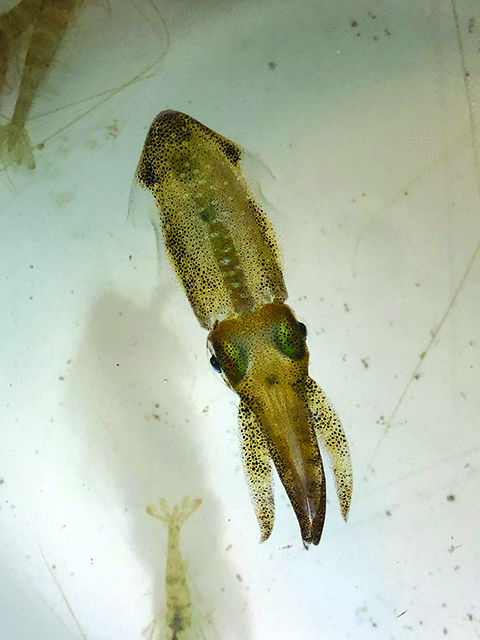
A SIGN OF THE TIMES
Being the taga-pamalengke (wet market shopper) of the family during my bachelor years, I recognized this squid as the common reef squid. I saw them often whenever I went snorkeling in shallow waters or on coral reefs. As you would have guessed, they were attracted by the light. One of our companions was able to scoop up with his net a beautiful specimen weighing about 1 kilogram.
I know that this is already cliché, but I have to say that my encounters with big specimens got rarer as time passed. About a decade ago, I still got to swim with good-sized squids, albeit from a bit of distance. Nowadays, I’d consider myself lucky if I were to meet finger-length juveniles while swimming.
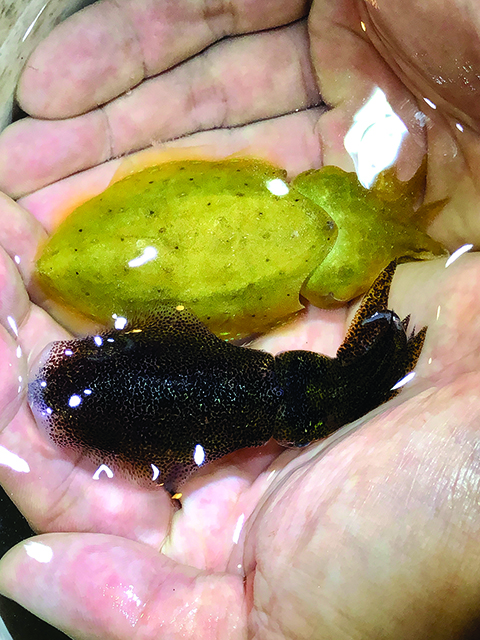
ANOTHER DISCOVERY
After the show and tell with the pamangkins, I went back to the water to wash the ink goo off my net. This time, I noticed a queer orange tennis ball floating in mid depth of the shallow water. It was staying close to a cluster of sea weed.
My lengthy experience of appreciating wildlife has taught me to recognize if an object was either moving or staying still in a suspicious manner. This is usually the case for camouflage animals. As they mimic their surroundings, there are a few details that they cannot completely copy. These little details can give them away, if one is able to observe very carefully.
As I drew closer, my heart rate began to speed up that I could feel a thumping sensation in my head. I realized that this “tennis ball” was actually a yellow-orange cuttlefish, a beautiful little fellow that is sometimes yellow, sometimes orange and sometimes yellow-orange.

IN POTENTIAL DANGER
Based on my experience, cuttlefish encounters are rarer than squid but are easier to catch. Let me rephrase that: Maybe cuttlefish encounters are rarer because they are masters of camouflage, while the common reef squid travel in bigger numbers and are always in the open. Squid are harder to catch because there are in the open water and rely not only on camouflage but also on their relatively faster swimming to get them out of reach. I cannot catch the squid if I do not have my nets or fishing equipment. Meanwhile, the cuttlefish have far better disguise mechanism. Like the octopus, you would not know they are there.
Just a week ago in another beach location, I noticed that a clump of seaweed was actually a good-sized cuttlefish that would have weighed almost a kilogram. However, this superior skill of camouflage was also the cuttlefish’s downfall. Their confidence in this ability would cause them to become easy prey for spearfishing and netting.
I have encountered a pair of really big cuttlefishes a few years ago while snorkeling in the reef of Arena Island, Narra, Palawan. The area was protected from local fishermen and the sea life was just incredibly abundant. They were truly magnificent to swim with and with our initial approach, they did not swim away. Only when they realized that their camouflage was not working against us did they start to keep a safe distance. I was glad they resided in this particular reef and I did not have to worry for their safety. These impressive specimens would weigh somewhere between 2 and 3 kilograms each and that would make any fisherman go crazy.
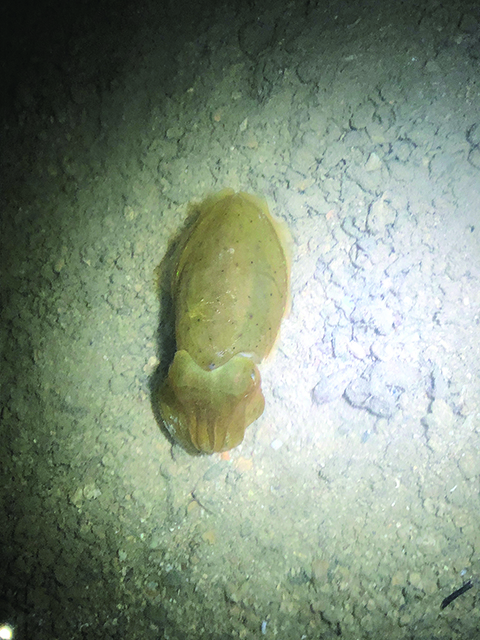
TIMID FELLOW
That was not the first time that I encountered a juvenile cuttlefish. I actually discovered a clump of cuttlefish eggs earlier this year that were near hatching. I could see the tiny cuttlefishes somersaulting within each of their almost crystal clear egg case.
I also caught bigger specimens in shallow waters before, one of them about 10 inches from tip to tip.Similar to my previous experiences, this one also relied too much on its camouflage and did not swim away when I approached it. I gently coaxed it to enter my net with my free hand and, without causing any fuss, it went in. Only when I lifted the net did it begin to panic and performed another ink-fest. I am not really sure if this specimen from Buko Beach Resort is a common cuttlefish, because unlike the others I had seen, which adapted the color brown or grey most of the time, this one was always yellow or orange. It only appeared brown when the light was dimmed. I kept the transfer to the pail as quick as possible, so I was not able to get a good picture of it out of water. It looked very cute. Because of its bulging eyes, its head and tentacles looked like a sad puppy’s face. In other angles, it looked like a person’s hand with eyes drawn on the knuckles.
The cuttlefish had a calmer demeanor than the squid. While it didn’t struggle or fight me off, I had to remember to be very careful in handling the little guy. While it was inside the pail being watched by my platoon of nieces and nephews, it stayed timidly at the bottom of the pail, waiting for all the excitement to pan out. It did not fill my pail with gooey ink like what the squid did. I guess that is the word I am looking for to describe all the cuttlefish that I have come across: timid.

SAFE AT HOME
It was already past 10 PM and the kids were already getting sleepy [photo: Assorted specimen 1a]. The lesson time for the kids had ended. My back, neck, and eyes were sore from walking around all night with my body and neck bent towards the water and with my eyes staring almost unblinkingly for more than two hours. It was time to release everything back into the water.
The Suahe skittered away and disappeared quickly. That was because they buried themselves in the soft sand. The fishes swam away slowly. They were dazed by the sudden change in brightness and the swaying of the pail as we brought it close to the water.
The squid did something interesting. It moved in a slow but calculated speed away from us. When we raised our flashlight to see it clearly, it went back to its pitchfork defensive stance. As for the cuttlefish… you guessed it! It swam away timidly.
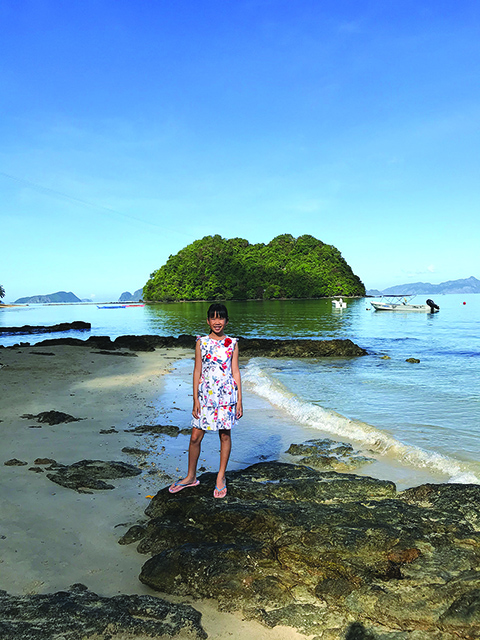
ANOTHER DAY
The next day, we did the same routine at Maremegmeg Beach, in the same area where we caught the Rockskipper and the Shore Crabs the previous month. We had a hearty dinner at the Maremegmeg Beach Club to fuel and prepare our bodies for the nightlong trip.
It was very fortunate that the tide was much lower than our previous month’s visit to this same area. However, except for my cellphone, I was not able to bring my usual stuff with me because I had to take passengers in my car coming to Maremegmeg Beach. I thought that I would just take pictures of the animals we encountered there – no need to catch them. Just a few moments later, I would feel both regret and gratitude that I did not have any net or line with me.

During my previous visit, we did not see other creatures aside from the Rockskipper and the Shore Crab. This was because the tide was higher and we could only explore the big rocks that were bordering the water. This time around, the tide was really low, exposing submerged rocks where fish normally hid on a regular tide.
What we experienced was really amazing. We saw a number of Cowrie Shells crawling on the rock surfaces, foraging for algae and other edible organic material. These guys used to be very common, but it had been quite a long time since I last saw live Cowries, not to mention in such healthy numbers. They were indeed very pretty. Since I did not have any container, I showed them to the kids on the spot and gave them a short lesson about the shells before putting them back to where we found them.
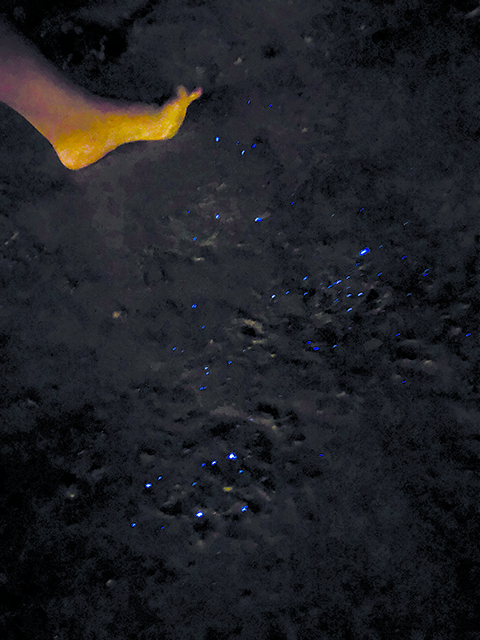
STEP BY STEP
After the encounter with the Cowrie Shells, I noticed something strange as we took steps on the sand in ankle-deep waters. I thought my eyes were just tired because I thought I saw a dim eerie glow in the water. It was so faint that it was very hard to notice and it made one doubt if it was a glow or a reflection. Then, a sudden realization hit me and a long lost memory resurfaced. It was a faint memory from my elementary years. It felt more like a dream than a memory, but I could remember walking in the sand one night, and my footsteps were glowing! I was so small then that I did not know what to make of it.
Armed with this memory, I realized what I must do. I had to get out of the water, so I led my pamangkins to the waterline where the small waves brushed gently against the sand. It was here where the glowing light became very clear. It was exactly like stars embedded on the sand instead of the sky.
It seemed like we had run into sand saturated with glowing planktons. The kids were really awestruck! Those planktons were called bioluminescent Dinoflagellates. They glowed when they were disturbed, or in this case, when stepped on. The curious little buggers were literally illuminating our footsteps!
I saw an episode on Discovery Channel about these things. On the show, the planktons are resting on the sea floor. The narrator said that the “light on impact” is their defense mechanism, because the shrimp that eats them become illuminated and become the target of predators. Thus, the shrimp will be dealt with quickly and could no longer eat more plankton.
The long name given to these guys is a fun tongue twister as well. In fact, I almost titled this story ABDCE (Ang bioluminescent Dinoflagellates at Cephalopods ng El Nido). I realized then that it was time to head back towards the hotel.
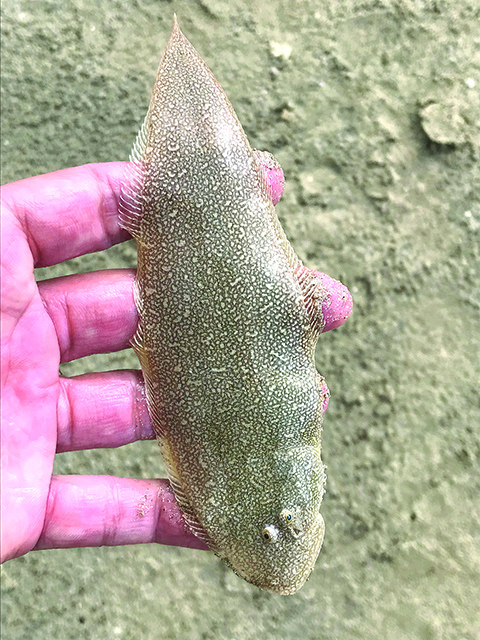
SAND TRAIL
I kept my cellphone flashlight on while heading back. We could still see those little fishes staying still near the surface of the water, blinded by the bright light. It would have been quite exhilarating to stay and observe them, but the night was getting late. While trying to decide whether to tarry or to hurry, there was a sudden movement in the shallow part of the water, kicking up sand that seemed more like a trail of smoke coming from the locomotive of a train.
That was a familiar sight to me, although I usually saw something like that during the daytime. I did not think these critters would be sleeping in this area during the night, because I usually encountered these guys in sandy beaches, not on rocky areas. But I guess it also made sense, since the submerged rocks protected them from the waves and from predators.
As I approached and peeked closely, my guess was validated. The creature that made this signature straight line dash with smoking sand effect was none other than the Tongue Sole. I have observed other flatfish before, like the flounder. They also made that sudden dash out of their hiding place, which was basically any sandy place where they half-buried themselves, but none of them swam off this straight and none of them kicked up sand all the way to the next hiding place.
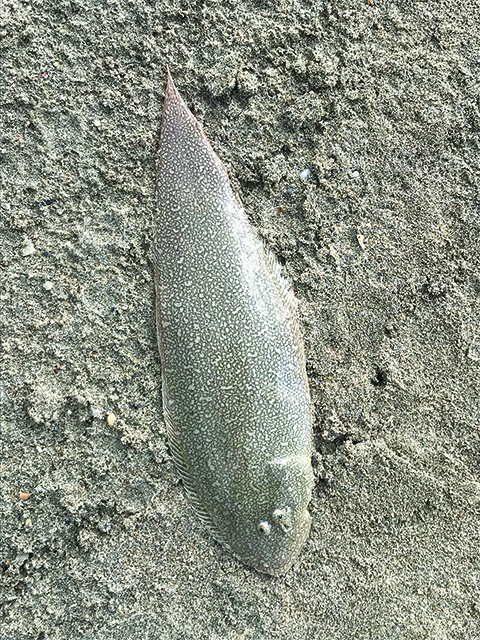
FLAT WONDER
Floun Soles are hard to find because they stay in a very particular spot on the beach. And as you would have guessed, they are expertly camouflaged. But once you know where they hang out, they will be easy to find.
The Tongue Sole I found was both easy and hard to find. It is unfortunate that our government is not keen on the proper identification of animals, nor the publication of descriptions. I had a hard time and was not able to identify the species of this fish.
I placed the specimen I took pictures of on dry sand so that it could not bury itself. But even in this state, the fish would have been hard to see if it were not for the closeup picture.
As for their camouflage, they are quite easy to flush out with the right technique. I plan to write more about these flat wonders next time.
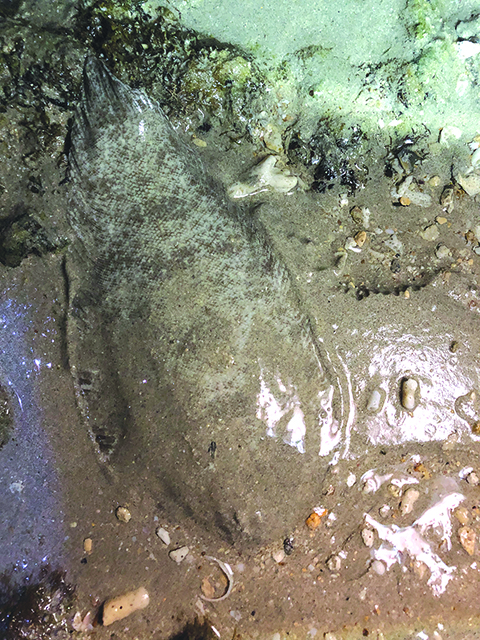
ELUSIVE CREATURE
Tongue Soles do not swim very far when startled from their hiding place. Obviously, their strength is on camouflage, not marathon.
I spotted and stalked a number of them at Maremegmeg Beach that night. With my flashlight-mode cellphone in my left hand, I had to use my right hand to catch the sole barehanded. I regretted not bringing any tools for catching fish – no pail, no net, and not even a drinking glass, which could sometimes be pretty handy in catching small fish at night. I am very much experienced in catching fish with my bare hands, but my quarry are usually fry or baitfish. I seldom get the chance to use my bare hands for fish bigger than 4 or 5 inches, not to mention catching them with only one hand.
Blinded by my light, they would stay put and rely on their camouflage for safety. Taking advantage of this, I had to move slowly and steadily, focusing my light on their eyes while moving my free hand so that it was over where they were hiding, but not blocking the light from shining into their eyes. If my hand blocks the light, then they saw the giant shadow hovering very near them and off they would go.
I was successful in pinning some of them down with my hand against the sand. The reason for their escape was that I had to keep my hand from crushing the fish while exerting enough pressure so that they did not give me the slip. Unfortunately, the Tongue Sole was extra flat and extra slippery. As I curled my palm into a fist to get the fish out of the sand and water, the fish would wiggle and flip out of my hand. Eventually, I got only one Tongue Sole.
My army of small followers were ecstatic with this find. Little did we know that there was something much bigger lurking in the waters nearby.
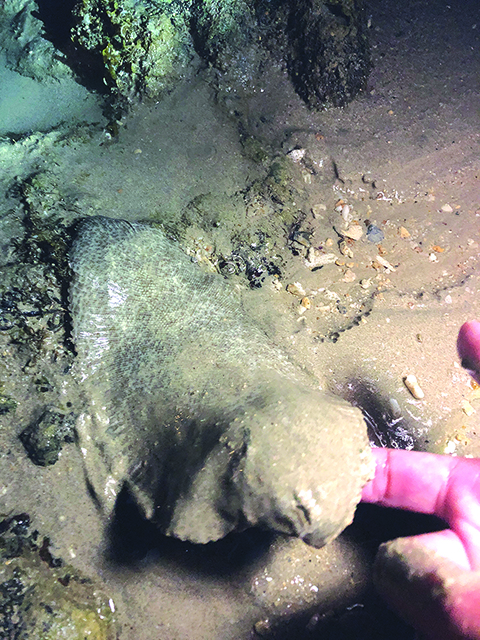
CALM ENCOUNTER
After releasing the Tongue Sole, I noticed a strange shape in the water. There was a mound on the sand surface that looks strangely perfect in its tear-shape form. My heart began to race as I realized that the silhouette had eyes and a mouth faintly bulging out of the water and my mind was finally able to picture the Flounder under that thin sheet of sand. Sure, Tongue Soles sometimes also left a fuzzy mark of their shape on the sand surface. But because they were smaller and so much flatter, the mark they would leave on the sand was very faint that I would not use it as a reliable means of locating them.
Meanwhile, the shape of the Flounder was very obvious. This one was definitely more than 8 inches long and I had never bare-handedly caught something this big before. I had hand-caught big fish on previous occasions, but with the aid of a net or even a tin can.
I tried to calm myself down as I signaled the kids to assist me. I had to remind them to keep a safe distance so as not to startle my quarry. Their movement also stirred up sand that clouded the water. I had to explain to them quickly that I needed the water as clear as possible. After all, Flatfishes were masters of camouflage.
With someone holding my flashlight-mode cellphone, I finally had both hands free. It was probably over confident with its camouflage that I got close enough and was able to pin it down. Similar to the Tongue Sole, it did not struggle at first. It is probably trying to assess my movement and waiting for the right opportunity to make that strong burst of strength to get free.
Learning from my earlier mistakes with the Tongue Soles, I made sure that there was no mistake this time. With my left hand pressing it down on the sand, I used my right hand like a muzzle, snuggly fitting into its head. And then, I slowly shifted my left hand from flat to cup shape to secure its rear. So, in just a minute or two, the Flounder was “bottled up” by my hands and unable to escape.
BRIEF CONTACT
All the kids screamed with glee. It was a very curious creature indeed. Dull gray on the top side and ghostly white on the underside. Unlike the slender Tongue Sole, the Flounder was bulkier, wider, thicker, and meatier.
The smaller children also touched the skin of the flounder while letting out the usual “Ew!” Everyone then agreed to let it go.
I wish I could tell our readers more about Tongue Soles and Flounders, but I believe these curious fellows deserve their own feature story. And there are other very fascinating land creatures that deserve the spotlight this year. As for the next story, I am thinking of flying dragons and giant beetles.
DID YOU KNOW?
Ariel’s best friend Flounder is not an actual Flounder.






